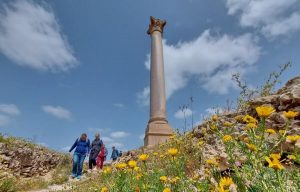Pharaoh Sneferu (Snofru or Snefru) (r. 2613-2589 BCE) constructed three big pyramids and maybe two smaller ones. The cut and prepared stone of his Pyramids total about 5 million cubic yards (almost 3 1/2 million cubic meters). Pharaoh Sneferu’s main construction projects were at Meidum (20 miles / 30 km south of modern Cairo) and Dahshur (12 miles / 20 km south of Cairo).
The Pyramid at Meidum
Sneferu’s first effort at Pyramid construction was Meidum. Some historians think that this unique building began as a step Pyramid and was subsequently transformed into a genuine Pyramid with flat triangular sides by the addition of more material. The whole outer shell has collapsed, maybe while it was still being erected, making it difficult to determine the original form. What’s left is a massive, 210-foot-tall (65-meter) steep-sided cube with two-tiered stairs at the top, surrounded by deep debris mounds. Two more steps appear to have existed in the 15th century but have subsequently fallen.
Although it is possible that this structure was desecrated for ceremonial purposes, conventional archaeology believes that the collapse was caused by poor architecture and that the Pyramid at Meidum marks a step backward in Pyramid construction.
Sneferu’s Pyramids at Dahshur The Bent Pyramid
For his next project, the distinctive “Bent” Pyramid, Sneferu moved to Dahshur (Dashur or ancient Dashhoor). Unlike any other known Pyramid, the angle of the flat sides varies from 55 to 43 degrees at the midway of the sides. Archaeologists are quick to assume that the structure was failing and that a change of designs was necessary. The building does, in fact, contain fractures. Another theory is that the Egyptians, who were always aware of the symbolic and hyperdimensional importance of forms and angles, purposefully built the Pyramid in this shape to achieve the desired effect. The Bent Pyramid stands at a height of 344 feet (105 meters).

A little Pyramid may be found south of the Bent Pyramid, as well as a funerary temple on its eastern side. The original polished limestone exterior shell is substantially intact, giving this Pyramid the most accurate representation of the Egyptian Pyramids.
The Bent Pyramid is unique among the great Pyramids in that it has two entrances on opposite sides, one on the north (as is typical) and one on the west (as seen in the upper cutaway pictures). This, like virtually everything else about the Pyramids, has sparked debate over its meaning and function.
To keep tomb thieves out of the interior rooms, the Egyptians devised a number of ingenious methods. This is a basic stone sliding door that is meant to be difficult to open once closed. The open posture is seen in the top image, with the hefty stone slab pushed to the right. The stone underneath has shifted to close the gap. A side view is seen to the right.
The Red Pyramid
The Red Pyramid in Dahshur, located 2 1/2 miles (4 kilometers) north of the Bent Pyramid, is 340 feet (104 metres) tall and has flat triangular sides at a 43 degree angle. Whatever engineering issues arose during the construction of the Meidum and Bent Pyramids were overcome, and the Red Pyramid has remained in great shape throughout the years, save for the theft of its beautiful limestone casing and royal jewels.

The Pyramid’s color and name come from the reddish color of the lower-quality local limestone used in its construction. The Red Pyramid is Egypt’s third-biggest pyramid, only surpassed by Sneferu’s son and grandson, Cheops and Chephren.
Geologist Robert M. Schoch investigated the Red Pyramid’s center chamber and found that, unlike the rest of the interior, it displays significant weathering, as if it were a much older structure that was encased by the Pyramid’s construction. The practice of integrating significant parts of older wall sculptures into later reliefs is well-known in Egyptology, thus the notion of an ancient-at-the-time temple beneath the Red Pyramid has a lot of merits.










